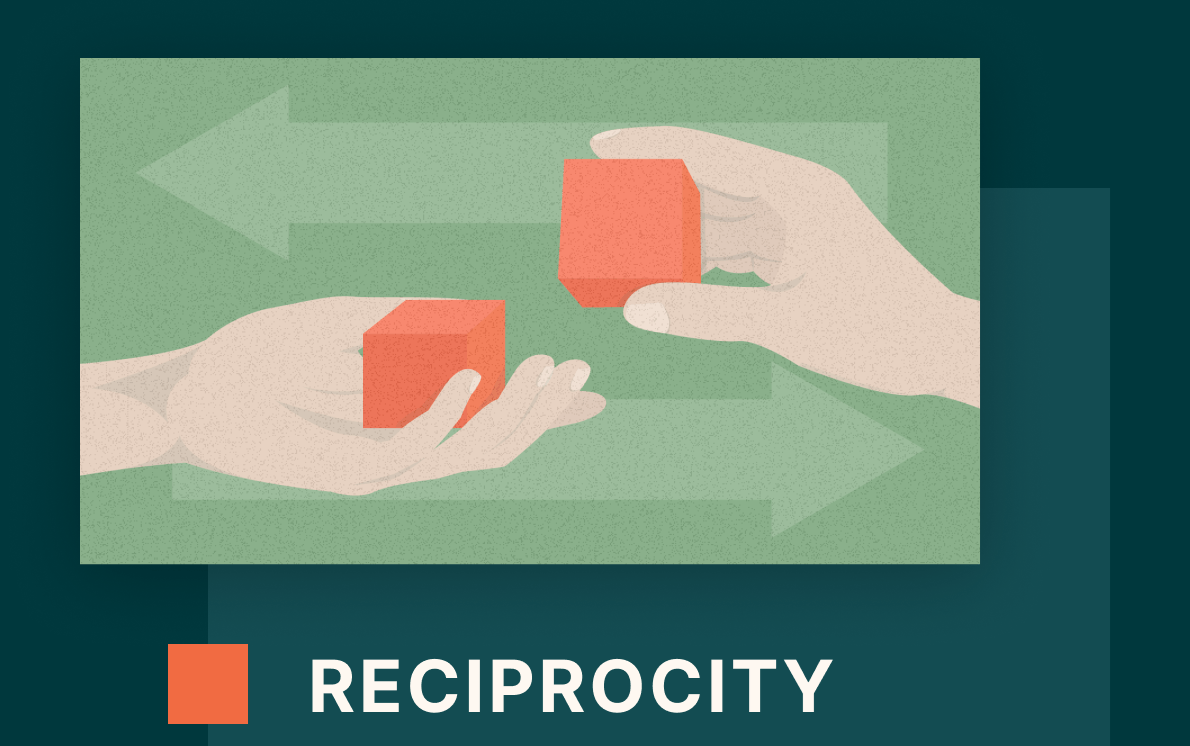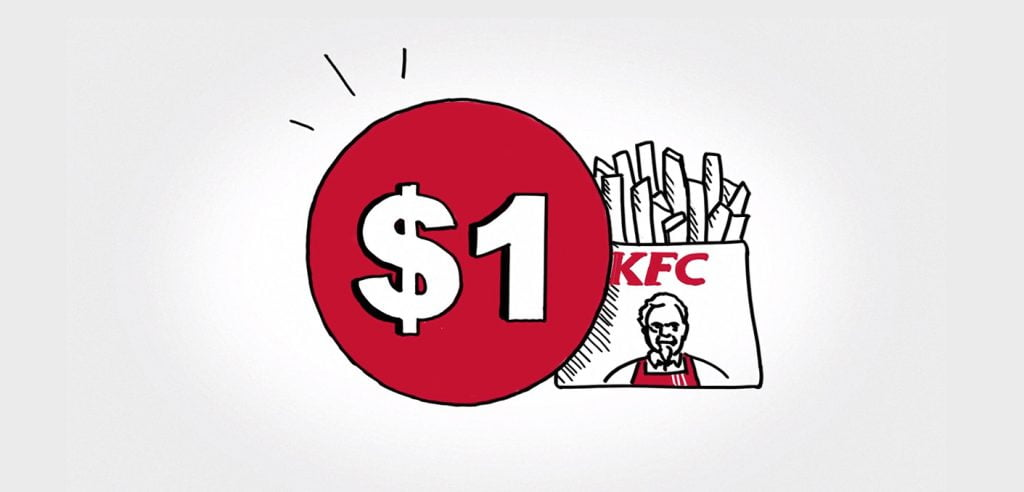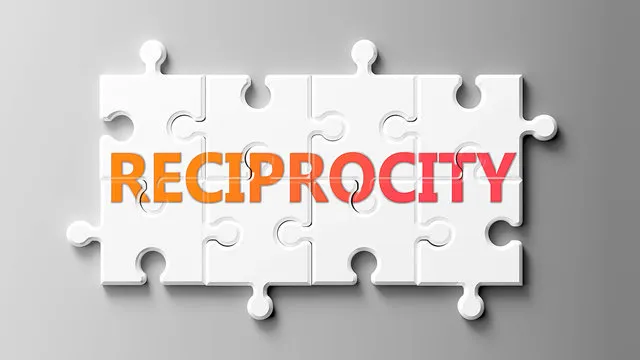Reciprocity – A seemingly familiar saying but is a social psychological rule that has been proven by many studies and practices to have a great influence on consumer behavior and decisions. This is also a psychological phenomenon that many big brands apply every day in gift campaigns, marketing messages, and customer care,… typically KFC and its communication campaign that skyrocketed potato sales by 54% thanks to the application of the psychological rule “Reciprocity”.
The law of “Reciprocity” is a principle of social psychology in which people tend to reciprocate when they receive a positive action or help from others. In fact, this psychological phenomenon is formed from social norms, just like in Vietnam, our ancestors have always conveyed the concept of “repaying gratitude” when receiving kindness. Good things from someone, everyone needs to be grateful and compensate them appropriately.
Over time, this law penetrates deeply into human behavior and living habits and becomes a very common psychological phenomenon with a profound impact on life. Therefore, when we receive help or receive a positive value from someone, we will feel very uncomfortable if we cannot reciprocate. Another downside of this psychology is that when receiving negative, negative actions, people will tend to react with a greater degree of discomfort, and even more brutality.
Another obvious consequence of this mentality is “concession”. For example, when you go to bargain with the seller: Initially they offer 10K, you ask them to sell for 5K. Finally they offer 7K and you start to feel like “The seller has given in” “The price has been reduced for me”, so you feel like you should give in like the seller and agree to the price. 7K.

Reciprocity in Marketing & Business
In life, the rule of Reciprocity is often mentioned in human relationships, but in fact it is also a psychological phenomenon that many businesses exploit in business. and marketing to make it impossible for users to leave them. This psychological phenomenon is one of the reasons behind free gifts, promotions or community activities of some brands today….
This psychological effect is used in marketing by providing benefits and value right from the start to customers, even before they have used or purchased the product, causing customers to form a feeling of “Reciprocity”, creating gratitude towards the Brand. Thereby urging their support for the brand, stimulating the word-of-mouth effect or making them decide to buy the product more quickly. This psychological effect sounds quite simple, but it is a psychological law that is always present within each person. Therefore, if you know how to apply the “have and get back” mentality, brands can easily shorten the gap, turn consumers into loyal customers and thereby indirectly boost sales.
Case Study: KFC applied Reciprocity to increase sales by 54%.
The psychological rule of “Reciprocity” has been applied by many brands from large to small in marketing and business, KFC is one of them. In 2014, KFC Australia gave Agency Ogilvy a problem: It was to increase sales of this brand’s french fries product, which is being sold for $1.

Faced with this problem, Ogilvy will not be able to change the price of the product, the brand can only change the way people perceive the product to boost its sales. To influence consumer perceptions of price, Ogilvy began analyzing customer psychographics. Ogilvy tested five different Advertising messages for KFC’s $1 french fries, corresponding to five common psychological principles, one of which is the “Reciprocity” mentality:
- Loss Aversion: “$1 French fries won’t last forever.”
- Reciprocity: “You want free fries, but we’ll meet you halfway with fries for just $1” – Meaning “You want free fries, but we’ll Reasonable response to $1 fries.” KFC acknowledged the wishes of buyers and showed the brand’s “concession” when selling potatoes at a cheap price of only 1 USD. This makes buyers feel that the brand has really made concessions to them, which stimulates them to agree, even love the potato dish at the price of 1 USD.
- Return Value: “French fries for $1 – On-site purchases only.”
- Anchor Rule: “The price is so good you can only buy four.”
- Social Norm: “Everyone likes our fries for $1, why don’t you?”
The results showed that messages built on the psychology of Reciprocity and the anchor rule were significantly more effective. The results of the campaign boosted sales of KFC’s $1 French fries by 56%.
Applications of Reciprocity Psychology in Marketing
You don’t necessarily have to give material gifts to make customers feel grateful
Not only specific gifts such as promotions, physical gifts, etc. can create this mentality. There are two types of “gifts” that brands can bring to customers to promote Reciprocity psychology, including:
- Material: These are gifts of tangible things that your customers are likely to enjoy. For example, special discounts, limited offers, points accumulation,…
- Emotion: Brings emotional values such as: Feeling of being cared for by the brand through survey programs collecting customer feedback, personalized thank you letters to each customer goods,… Or more macro are community social activities, contributing value to the locality where they were born, contributing to protecting the living environment, the earth,…
However, whether giving gifts creates a Reciprocity mentality or not depends on the time you give the gift to customers. You should choose the time to give gifts early, before they make a purchasing decision, especially when they are considering and comparing. For example, if a customer has visited your website and is in the process of comparing your product with another brand, you need to quickly send a “gift” to them at this stage to motivate their purchasing decision. For example, send them free materials, display a special discount voucher after they have finished viewing the product, etc. instead of giving customers a gift after they have purchased.
In addition, surprise is also an important factor that makes customers feel that the gifts you bring become more valuable and meaningful. Therefore, you can choose unexpected times to give gifts to customers. For example, about a few dozen seconds after they see the product price on the website, you suddenly pop up an exclusive discount voucher exclusively for customers.
Make your customers feel like this price is a compromise
KFC’s application is an example of this method. When customers feel that the offer you offer is very generous, they will feel the need to reciprocate, which is a concession between both parties. So how do you make customers feel like you’ve made concessions?
Use the door-in-the-face strategy: This is a strategy that helps you persuade the other person to comply with your request by making a big request that there is a high chance the respondent will refuse. Then start adjusting the second request to be more suitable. Then, from the psychology of comparison with request 1, the user will most likely agree with request 2 quickly. For example, there are some brands that initially offer products at very high prices, then launch main products at cheaper prices and say that these are the brand’s efforts to optimize costs. …. Let users see their efforts in price optimization.
Beware of Reciprocity – Always put the interests of users and the community first
It is also an especially important note when you want to use reciprocity psychology. Always show users the values that the brand has “sacrificed” for them, for example from small actions such as the brand negotiating with the carrier so that customers can receive free shipping, asking for additional vouchers from retailers. E-Commerce platform for customers,… In general, let customers see what the brand has done for them, before aiming to promote products or push sales.
Conclusion:
In general, the psychological law of Reciprocity “Reciprocity” is not only a social norm but has gradually become a habit that is formed and deeply affects human behavior. Under the influence of Reciprocity, customers can become loyal advocates of the brand, stimulating the word-of-mouth effect and making them make purchasing decisions quickly.
Reference: Inside BE
Comment Policy: We truly value your comments and appreciate the time you take to share your thoughts and feedback with us.
Note: Comments that are identified as spam or purely promotional will be removed.
To enhance your commenting experience, consider creating a Gravatar account. By adding an avatar and using the same e-mail here, your comments will feature a unique and recognizable avatar, making it easier for other members to identify you.
Please use a valid e-mail address so you can receive notifications when your comments receive replies.
